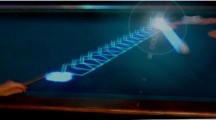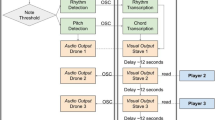Abstract
Gamelan digitization is one of the efforts to introduce and preserve traditional Indonesian musical instruments not to become extinct. The focus of digitization in research is only on one type of saron musical instrument because the saron instrument is the main melody in a gamelan instrument that can be played individually and is more harmonious when played in collaboration. The most important thing in playing gamelan instruments is playing several types of musical instruments at the same time, especially the saron instrument. In using the saron instrument itself must be played collaboratively according to the tempo. For this reason, to make the interaction design model, the Call and Response System method is used, which has a “your turn” indicator and the Rhythmic Emphasis Weighting method connected to the “Techno Rhythm Monitor”. The application of the two methods above, the interaction design modeling design uses the Design Thinking method. The research testing using the System Usability Scale (SUS) because the results have a high level of validity for a study. The test results from research using the Call and Response System and Rhythmic Emphasis Weighting methods resulted in an interaction design model playing the saron musical instrument that can collaborate according to the tempo. For the test results using SUS, which obtained a final result of 85%, it is at level B and means that the interaction design model that has been designed is acceptable because it has met the user’s goals (proper).
Access this chapter
Tax calculation will be finalised at checkout
Purchases are for personal use only
Similar content being viewed by others
Notes
- 1.
*Supported by Telkom University.
References
Osterhammel, J., Petersson, N.P.: Globalization: A Short History. Princeton University Press (2021)
Walton, S.P.: Aesthetic and spiritual correlations in Javanese gamelan music. J. Aesthet. Art Criticism 65(1), 31–41 (2017)
Born, G., Devine, K.: Music technology, gender, and class: digitization, educational and social change in Britain. Twentieth-Century Music 12(2), 135–172 (2015)
Purwadi: Seni karawitan Jawa: ungkapan keindahan dalam musik gamelan. Hanan Pustaka, Yogjakarta (2006)
Walton, S.P.: Collaboration, feeling and the partnership of the spiritual and musical in Javanese Gamelan music. J. Asian Music Res. Inst. 23 (2001)
Becker, J.: Traditional Music in Modern Java: Gamelan in a Changing Society. University of Hawaii Press (2019)
Blaine, T., Perkis, T.: The Jam-O-Drum interactive music system: a study in interaction design. In: Proceedings of the 3rd Conference on Designing Interactive Systems: Processes, Practices, Methods, and Techniques, pp. 165–173 (2000)
Kaya, A., Ozturk, R., Gumussoy, C.A.: Usability measurement of mobile applications with system usability scale (SUS). In: Calisir, F., Cevikcan, E., Akdag, H.C. (eds.) Industrial Engineering in the Big Data Era: Selected Papers from the Global Joint Conference on Industrial Engineering and Its Application Areas, GJCIE 2018, June 21–22, 2018, Nevsehir, Turkey, pp. 389–400. Springer International Publishing, Cham (2019). https://doi.org/10.1007/978-3-030-03317-0_32
Sharfina, Z., Santoso, H.B.: An Indonesian adaptation of the system usability scale (SUS). In: 2016 International Conference on Advanced Computer Science and Information Systems (ICACSIS), pp. 145–148. IEEE (2016)
Roh, J.H., Wilcox, L.: Exploring tabla drumming using rhythmic input. In: Conference Companion on Human Factors in Computing Systems, pp. 310–311 (1995)
Plattner, H., Meinel, C., Weinberg, U.: Design-Thinking. Mi-Fachverlag, Landsberg am Lech (2019)
Sauro, J., Lewis, J.R.: Quantifying user research. In: Quantifying the User Experience, pp. 9–18. Elsevier (2016). https://doi.org/10.1016/B978-0-12-802308-2.00002-3
Wolniak, R.: The design thinking method and its stages. Systemy Wspomagania w Inz˙ynierii Produkcji. 6(6), 247–255 (2017)
Carlgren, L., Rauth, I., Elmquist, M.: Framing design thinking: the concept in idea and enactment. Creat. Innov. Manage. 25(1), 38–57 (2016)
Diderich, C.: Design Thinking for Strategy. MP, Springer, Cham (2020). https://doi.org/10.1007/978-3-030-25875-7
Schlatter, T., Levinson, D.: Visual usability: principles and practices for designing digital applications. Newnes (2013)
Woolrych, A., Cockton, G.: Why and when five test users aren’t enough. In: Proceedings of IHM-HCI 2001 Conference, vol. 2, pp. 105–108. C´epadu`es Editions, Toulouse, France (2001)
Author information
Authors and Affiliations
Corresponding authors
Editor information
Editors and Affiliations
Rights and permissions
Copyright information
© 2021 Springer Nature Switzerland AG
About this paper
Cite this paper
Jatiningtyas, S.P., Junaedi, D., Effendy, V. (2021). Interaction Design for Digital Saron Musical Instruments Using Call and Response System and Rhythmic Emphasis Weighting Methods. In: Badioze Zaman, H., et al. Advances in Visual Informatics. IVIC 2021. Lecture Notes in Computer Science(), vol 13051. Springer, Cham. https://doi.org/10.1007/978-3-030-90235-3_11
Download citation
DOI: https://doi.org/10.1007/978-3-030-90235-3_11
Published:
Publisher Name: Springer, Cham
Print ISBN: 978-3-030-90234-6
Online ISBN: 978-3-030-90235-3
eBook Packages: Computer ScienceComputer Science (R0)




